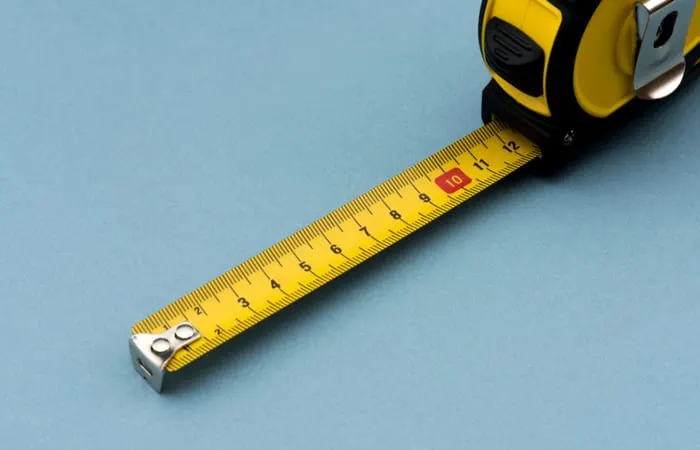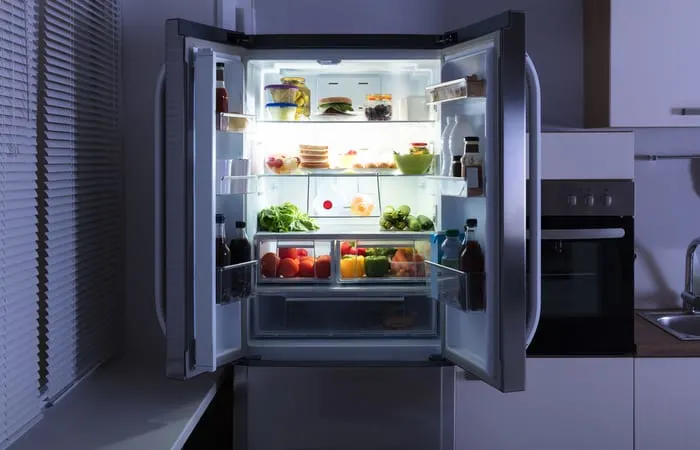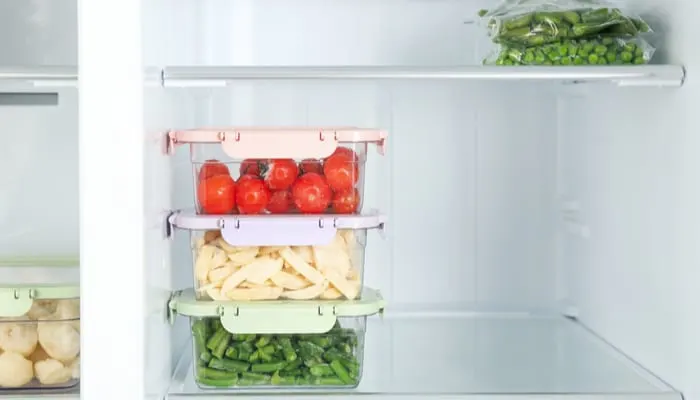If you’re looking for standard refrigerator sizes, you came to the right place.
It’s critical to have an accurate guide to ensure you buy the right size. Read on to learn how to measure yours.
Refrigerator Sizes Explained

Trong Nguyen/Shutterstock
Refrigerator capacity is measured in cubic feet. Refrigerators for home use may be less than 10 cubic feet for a compact-sized model. On the high end, some French door refrigerators can go up to 34 cubic feet.
Any refrigerator for sale will be advertised as having a certain cubic-foot capacity. The capacity refers to the combined storage space in the freezer section and fresh food compartment of this kitchen appliance.
But keep in mind that some numbers are inflated to make the marketing figures seem more impressive. Refrigerator sizes aren’t always accurate. Appliance manufacturers may overstate how much usable room their fridges have.
However, cubic foot capacity is a good starting point when determining refrigerator size. To give you an idea of how many cubic feet you need, use this rule of thumb. It’s based on the number of people in your household.
- One person in a household, at least four to six cubit feet
- Two-person household, from 12 to 18 cubic feet
- Three or four-person household, 20 feet and up
The exact size you’ll find convenient depends on how much you cook at home. What you cook is a factor too. Larger fridges are better at storing bulky items like frozen pizzas.
Other factors to consider include:
- How is refrigerator space divided between the freezer and fresh food? One to two is a typical ratio.
- What kind of shelves does it have? Adjustable, foldable shelves are more flexible.
- How about special features such as pizza slots, ice makers, and water dispensers?
There are many features available, from temperature displays to special compartments for defrosting frozen foods. Start by asking yourself how you’ll use the fridge. This will help cut through the confusion.
Four Refrigerator Types
Your exact refrigerator size and the way you measure will depend to a degree on the style or type of refrigerator.
There are four common designs of refrigerators:
- Top freezer refrigerators: These popular, inexpensive models range from 10 to 24 cubic feet inside. Outside, they may be 23 to 33 inches wide, 24 to 33 inches deep, and 65 to 69 inches tall.
- Bottom freezer refrigerator: These designs with a drawer near the floor for frozen goods are similar in size to top freezer models. They may be a few inches wider, however.
- Side-by-side refrigerator: freezer on the left, fresh food on the right; these are larger, ranging from 20 to 28 cubic feet. They may be 30 to 36 inches wide, 29 to 35 inches wide, and 67 to 70 inches tall.
- French door models: with two side-by-side doors and a bottom freezer drawer, these go up to 34 cubic feet. Externally, they are about the same size as side-by-side designs.
Some other options include:
- Compact refrigerators of 10 cubic feet or less These can fit almost anywhere in a dorm room, master bedroom, media room, or other limited space.
- Beverage coolers often fit under counters and have specialized racks and shelves for wine bottles and beverage cans.
- Deep freezes are often kept in basements, garages, and laundry and utility rooms; these can store large amounts of frozen food.
- Freezer-less refrigerators have an all-fresh-food design that is dedicated to storing fresh foods only.
Measuring Your Refrigerator
Before making your final choice, you have to consider the external refrigerator dimensions. These are, of course, its height, width, and depth.
However, you also have to consider how much space is taken up when the refrigerator doors open.
Accommodating a bottom freezer drawer when it slides out is another concern. Also, keep in mind that you’ll have to maneuver around the fridge when it’s in your kitchen. Make sure there is enough room for you to get by.
Even before that point, you’ll have to get the refrigerator into your kitchen. Refrigerators are large objects. You may find you have to remove the doors to squeeze one through a narrow entrance or hall.
Here’s how to measure the refrigerator and the space to assure a good fit:
Measuring to Fit

Dnd_project/Shutterstock
First, consider where you’ll put the refrigerator. If your refrigerator is going to be against a wall with no cabinetry overhead or on the sides, the size of the unit is of less concern.
However, some kitchens have a cabinet already constructed to hold the fridge. Measure that for height, depth, and width to avoid getting a fridge that’s too big. Leave an inch or two on the sides, back, and top of the appliance.
That will allow for the door hinges to operate and for the air to flow around the unit. Also, think now about how you will move the fridge into the kitchen. Measure doors and tight spots, such as stairways.
You can remove the doors to squeeze through otherwise impassable bottlenecks, but don’t cut it too close. You don’t want to have an expensive appliance you can’t fit into the kitchen.
Measuring Width

Andrey_Popov/Shutterstock
Refrigerators come in standard widths. A standard refrigerator will usually be one of these sizes:
- 30 inches wide
- 33 inches wide
- 36 inches wide
Again, leave an inch or two on either side of the unit to allow for airflow. You may need to allow for two and a half inches between the door hinge and the wall to let the door open fully.
Measuring Depth

New Africa/Shutterstock
Most refrigerators fit one of two measurements for depth:
- Standard-depth refrigerators are roughly 34 inches deep. This includes the handles. Note that standard-depth fridges will extend past the 24-inch countertop by six to eight inches.
- Counter-depth refrigerators are generally 24 inches deep, not counting the handles. They will give a more built-in look to your kitchen.
To repeat, you’ll need to add another couple of inches behind the appliance. This will let you fit in cords and water lines for an icemaker. It also provides air flow to keep the machinery cool.
Another concern is what happens when the doors or freezer drawers open. Be sure to account for this. You can get measurements for the door open 90 degrees or the fully extended drawer from the manual or showroom brochure.
Measuring Height

Lakov Filimonov/Shutterstock
If you have cabinets built in over the space for the refrigerator, pay attention to the appliance’s specified height. Look for a number for overall height, including hinges and covers.
Leave an inch (at least) between the top of the fridge and the bottom of the cabinets overhead. The cabinet will likely be shallow enough that the hinges and covers will not interfere with it. This gives you another inch or so to pay with.
Refrigerator Size Roundup
Sizing a refrigerator for the number of users, type of use, and space available requires no more than a tape measure as far as tools. However, you’ll also have to expend a little thought.
The hassle of getting a new refrigerator home and finding it won’t fit in the space or is too small is no fun, though. This is definitely a time when it is much easier to measure twice and fit once.
Make sure to tell us whether or not you liked our guide on refrigerator sizes. And while you’re here, check out our other complete guides!

